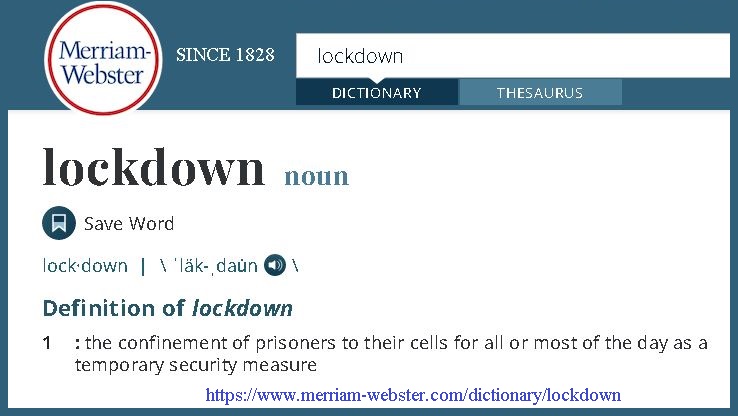Libertarian economics author Jeffrey A. Tucker recently exposed the surprising origins of the lockdown idea in an article for American Institute for Economic Research. [1]
To start, remember, the term “lockdown” originally applied to what happens at a prison after a riot:
Tucker wrote:
“How did a temporary plan to preserve hospital capacity turn into two-to-three months of near-universal house arrest that ended up causing worker furloughs at 256 hospitals, a stoppage of international travel, a 40% job loss among people earning less than $40K per year, devastation of every economic sector, mass confusion and demoralization, a complete ignoring of all fundamental rights and liberties, not to mention the mass confiscation of private property with forced closures of millions of businesses?”
He answers the question regarding the origins of the lockdown by reference to some emergency planning during a previous Federal Administration, by quoting a New York Times article:
“Fourteen years ago, two federal government doctors, Richard Hatchett and Carter Mecher, met with a colleague at a burger joint in suburban Washington for a final review of a proposal they knew would be treated like a piñata: telling Americans to stay home from work and school the next time the country was hit by a deadly pandemic.
When they presented their plan not long after, it was met with skepticism and a degree of ridicule by senior officials, who like others in the United States had grown accustomed to relying on the pharmaceutical industry, with its ever-growing array of new treatments, to confront evolving health challenges.
Drs. Hatchett and Mecher were proposing instead that Americans in some places might have to turn back to an approach, self-isolation, first widely employed in the Middle Ages.”
And what “science” was this idea based on?
The Times article continues:
“How that idea — born out of a request by President George W. Bush to ensure the nation was better prepared for the next contagious disease outbreak — became the heart of the national playbook for responding to a pandemic is one of the untold stories of the coronavirus crisis.
It required the key proponents — Dr. Mecher, a Department of Veterans Affairs physician, and Dr. Hatchett, an oncologist turned White House adviser — to overcome intense initial opposition.
It brought their work together with that of a Defense Department team assigned to a similar task.
And it had some unexpected detours, including a deep dive into the history of the 1918 Spanish flu and an important discovery kicked off by a high school research project pursued by the daughter of a scientist at the Sandia National Laboratories.
The concept of social distancing is now intimately familiar to almost everyone. But as it first made its way through the federal bureaucracy in 2006 and 2007, it was viewed as impractical, unnecessary and politically infeasible.”
Tucker brings the strands together:
“But what is this mention of the high-school daughter of 14? Her name is Laura M. Glass, and she recently declined to be interviewed when the Albuquerque Journal did a deep dive of this history.
‘Laura, with some guidance from her dad, devised a computer simulation that showed how people – family members, co-workers, students in schools, people in social situations – interact. What she discovered was that school kids come in contact with about 140 people a day, more than any other group. Based on that finding, her program showed that in a hypothetical town of 10,000 people, 5,000 would be infected during a pandemic if no measures were taken, but only 500 would be infected if the schools were closed.'”
So there you have it. America got locked down based on a high school computer simulation.
Tucker sums the amazing story:
“The primary author of this paper was Robert J. Glass, a complex-systems analyst with Sandia National Laboratories. He had no medical training, much less an expertise in immunology or epidemiology.
That explains why Dr. D.A. Henderson, “who had been the leader of the international effort to eradicate smallpox,” completely rejected the whole scheme.
Says the NYT:
‘Dr. Henderson was convinced that it made no sense to force schools to close or public gatherings to stop.‘”
People in Government, as always, over-react and then the “unexpected” consequences ensue. In this case, the Declared Pandemic was about a coronavirus with, as it turns out, a lower death rate than some “seasonal influenza” years, an which barely impacted children who seem mostly immune to the virus. Nonetheless, a Lockdown Plan which assumed children to be the major vector was implemented. Government science at work…
And now you know why you must assert your universal right of Informed Consent to refuse, resisist and raise your voice against the continuing harms caused by the continuing (now partial) lockdown.
https://tinuurl.com/maskexemption
[1] [https://www.aier.org/article/the-2006-origins-of-the-lockdown-idea]




I think you posted the wrong link at the end, is this it?
http://drrimatruthreports.com/mask-exemption-card/
Yes, that’s the right link.